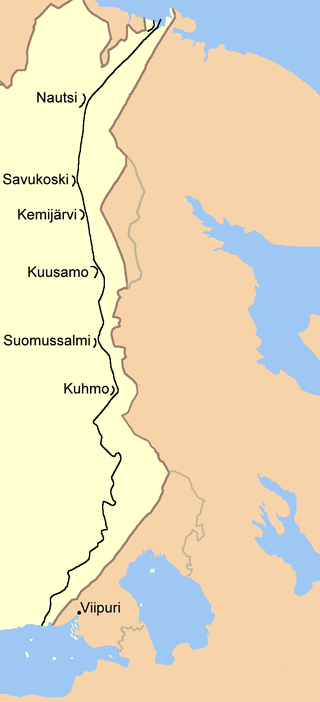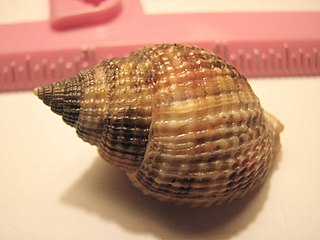
The Salpa Line, or its official name, Suomen Salpa, is a bunker line on the eastern border of Finland. It was built in 1940–1941 during the Interim Peace between the Winter War and the Continuation War and further in 1944 to defend Finland against a possible Soviet invasion.

Achille Valenciennes was a French zoologist.

Thaliacea is a class of marine chordates within the subphylum Tunicata, comprising the salps, pyrosomes and doliolids. Unlike their benthic relatives the ascidians, from which they are believed to have emerged, thaliaceans are free-floating (pelagic) for their entire lifespan. The group includes species with complex life cycles, with both solitary and colonial forms.

A salp or salpa is a barrel-shaped, planktonic tunicate in the family Salpidae. It moves by contracting, thereby pumping water through its gelatinous body; it is one of the most efficient examples of jet propulsion in the animal kingdom. The salp strains the pumped water through its internal feeding filters, feeding on phytoplankton.

Littorina is a genus of small sea snails, marine gastropod molluscs in the family Littorinidae, the winkles or periwinkles.

Apalone is a genus of turtles in the family Trionychidae. The three species of Apalone are native to freshwater habitats in North America; they are the only living softshell turtles from the Americas.
Ichthyoallyeinotoxism, or hallucinogenic fish inebriation, comes from eating certain species of fish found in several parts of the tropics, the effects of which are reputed to be similar in some aspects to LSD. Experiences may include vivid auditory and visual hallucinations. This has given rise to the collective common name "dream fish" for ichthyoallyeinotoxic fish.

Neritidae, common name the nerites, is a taxonomic family of small to medium-sized saltwater and freshwater snails which have a gill and a distinctive operculum. The family Neritidae includes marine genera such as Nerita, marine and freshwater genera such as Neritina, and freshwater and brackish water genera such as Theodoxus.

Eopsaltria is a genus of small forest passerines known in Australia as the yellow robins. They belong to the Australasian robin family Petroicidae. The name is derived from the Ancient Greek for "dawn singer/song" because of their dawn chorus. They are inquisitive and bold birds, and have been reported perching on the shoulders or boots of people in the bush. Open eucalyptus woodlands are their preferred habitat. The ornithologist John Gould likened the behaviour and mannerisms of the eastern and western yellow robin to those of the European robin. The name "yellow robin" itself was applied to the eastern yellow robin by the early settlers of New South Wales.

The salema porgy, also known as the dreamfish, salema, cow bream, karanteen, salpa, saupe, strepie or goldline, is a species of marine ray-finned fish belonging to the family Sparidae, which includes the seabreams and porgies. It is the only species in the monospecific genus Sarpa. It is found in the eastern Atlantic Ocean, Mediterranean Sea and southwestern Indian Ocean. This species has been known to cause ichthyoallyeinotoxism when eaten.

Cancellaria is a genus of medium-sized to large sea snails, marine gastropod mollusks in the family Cancellariidae, the nutmeg snails.

Several species of fish are claimed to produce hallucinogenic effects when consumed, a condition known as ichthyoallyeinotoxism. For example, Sarpa salpa, a species of sea bream referred to as the "dream-fish", is commonly claimed to be hallucinogenic. These widely distributed coastal fish are normally found in the Mediterranean and around the Iberian Peninsula, west to the Azores and along the west and south coasts of Africa. Occasionally they are found in British or more northerly waters. They may induce hallucinogenic effects similar to LSD if eaten. However, based on the reports of exposure they are more likely to resemble hallucinogenic effects of deliriants than the effects of serotonergic psychedelics such as LSD. In 2006, two men who apparently ate the fish experienced hallucinations lasting for several days. The likelihood of hallucinations depends on the season. Sarpa salpa is known as "the fish that makes dreams" in Arabic.
Hespererato is a genus of small sea snails, marine gastropod mollusks in the family Eratoidae, the false cowries or trivias.

Georgia Salpa Penna is a Greek-Irish glamour model.
The Salpa Line Museum was established and opened in 1987 by the municipality of Miehikkälä and by World War II veteran organisations. It is the first museum established in Miehikkälä. The other museums are the Miehikkälän kotiseutumuseo and the Miehikkälä local arts and crafts museum, which was established in 1989 and is located in the same building as the Engineers Museum.

Salpa fusiformis, sometimes known as the common salp, is the most widespread species of salp. They have a cosmopolitan distribution, and can be found at depths of 0 to 800 m. They exhibit diel vertical migration, moving closer to the surface at night. They can occur in very dense swarms, as solitary zooids or as colonies. Solitary zooids usually measure 22 to 52 mm in length. They are barrel-shaped and elongated, with a rounded front and a flat rear. Aggregate zooids are 7 to 52 mm in length individually. They are usually barrel or spindle-shaped.
Cyclosalpa is a genus of salps, marine tunicates in the class Thaliacea.
Achtheres is a genus of arthropods belonging to the family Lernaeopodidae.
Salpa Pokhari or Salpa Pond is a natural lake located in Dobhane village, Bhojpur District, Nepal. The lake lies at an altitude of 3443 metres and drains into the Sunkoshi River watershed.


















